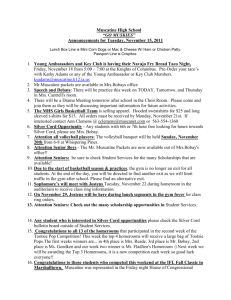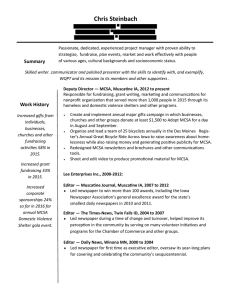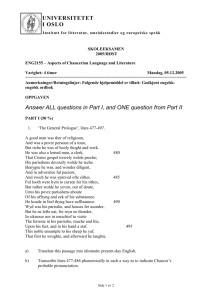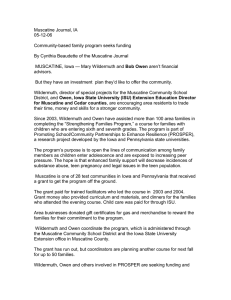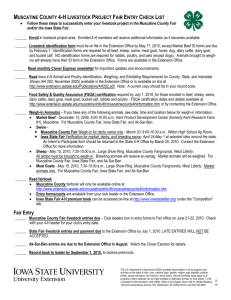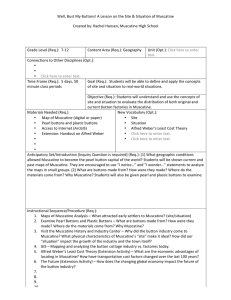Muscatine Journal, IA 09-13-06 Timely rain makes a difference
advertisement
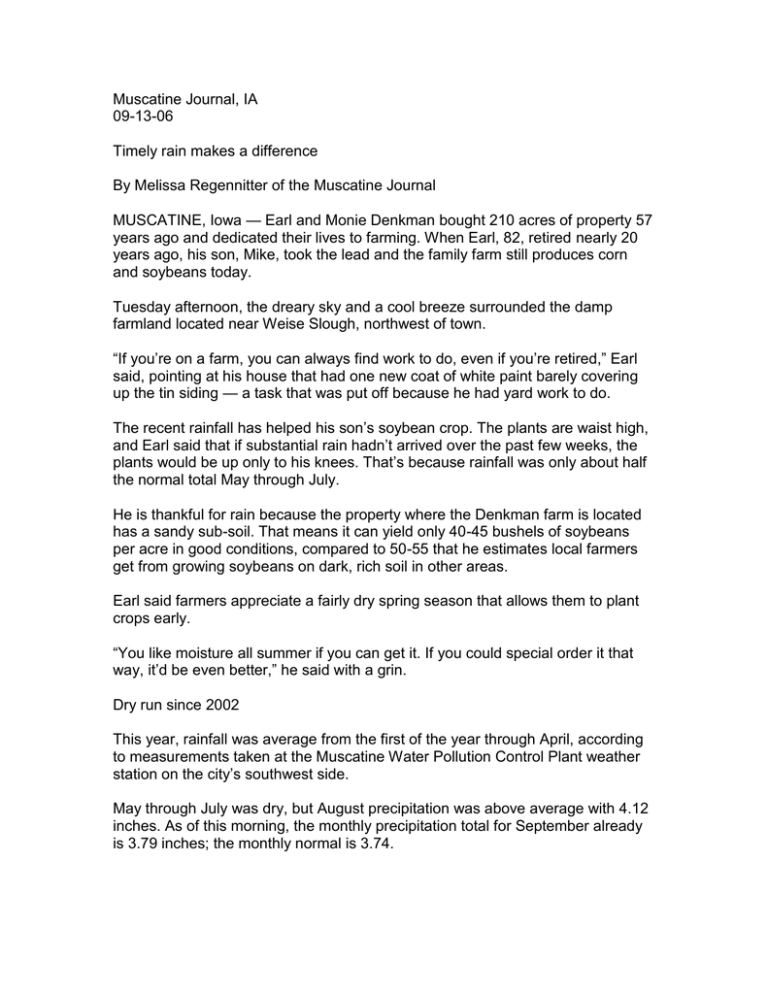
Muscatine Journal, IA 09-13-06 Timely rain makes a difference By Melissa Regennitter of the Muscatine Journal MUSCATINE, Iowa — Earl and Monie Denkman bought 210 acres of property 57 years ago and dedicated their lives to farming. When Earl, 82, retired nearly 20 years ago, his son, Mike, took the lead and the family farm still produces corn and soybeans today. Tuesday afternoon, the dreary sky and a cool breeze surrounded the damp farmland located near Weise Slough, northwest of town. “If you’re on a farm, you can always find work to do, even if you’re retired,” Earl said, pointing at his house that had one new coat of white paint barely covering up the tin siding — a task that was put off because he had yard work to do. The recent rainfall has helped his son’s soybean crop. The plants are waist high, and Earl said that if substantial rain hadn’t arrived over the past few weeks, the plants would be up only to his knees. That’s because rainfall was only about half the normal total May through July. He is thankful for rain because the property where the Denkman farm is located has a sandy sub-soil. That means it can yield only 40-45 bushels of soybeans per acre in good conditions, compared to 50-55 that he estimates local farmers get from growing soybeans on dark, rich soil in other areas. Earl said farmers appreciate a fairly dry spring season that allows them to plant crops early. “You like moisture all summer if you can get it. If you could special order it that way, it’d be even better,” he said with a grin. Dry run since 2002 This year, rainfall was average from the first of the year through April, according to measurements taken at the Muscatine Water Pollution Control Plant weather station on the city’s southwest side. May through July was dry, but August precipitation was above average with 4.12 inches. As of this morning, the monthly precipitation total for September already is 3.79 inches; the monthly normal is 3.74. Overall, Muscatine has had below-normal annual precipitation since 2002 and is still running below normal so far this year; 2005 was especially dry. The timing and amount of precipitation is key to crop success. According to Richard Cruse, a professor in the department of agronomy at Iowa State University, rainfall affects root growth differently, especially for the two major crops grown in the area. “Corn roots stop growing when the plant pollinates,” Cruse said. Pollination occurs early to mid July and is a crucial time in plant development. Too much rain early in the year or not enough later in the year may result in shallow root growth. “Relatively dry early and moisture later in the year —- that’s the best condition if there is sufficient water,” Cruse said, regarding corn crops. “Water later in the season helps fill out seeds.” After corn begins to reach maturity, the late- season rains do not benefit the seed growth very much. Once you begin to see the leaves on the stalks turn brown, typically late September, the plant is mature. Soybeans are different; the seed set occurs over a longer period of time and the plants are self-pollinating. Timing of the heat and moisture stress period is not as crucial in soybeans. For example, if there is a five- to 10-day stress period on corn during pollination, there will likely be a dramatic reduction in yield. Soybeans are a little less sensitive and it would likely take more severe heat and drought conditions to damage the crop, Cruse said. Another problem — and one aggravated by the lack of rain — is insect infestation. Soybean fields are more susceptible to bugs during a drought. According to Virgil Schmitt, Extension Crops Specialist with Iowa State University, this year’s crop yields will not surpass the record set in 2004, but most Muscatine area farmers should be pleased with this year’s yields. River level down According to Tom Nock of the Rock Island U.S. Army Corps. of Engineers, the Mississippi River at Muscatine was “not that much below normal.” According to Nock, the river was at a stage of 6.03 feet as of Tuesday afternoon near the Muscatine riverfront. The average stage for the year is 6.7 feet and the normal stage for this time of year is 6.3 feet. The stage is a measurement that the U.S. Army Corps of Engineers use as a benchmark. If that stage reaches 16 feet, the Muscatine riverfront area would be considered at flood stage. The Mississippi River has risen slightly due to recent rains, but that will subside soon if there are not more showers to the north of Muscatine. Knock said that in the past three years, lower than normal river flows for late summer and fall have become a trend on local rivers due to drought or neardrought conditions. Contact Melissa Regennitter at 563-263-2331, Ext. 317, or mregennitter@muscatinejournal.com

